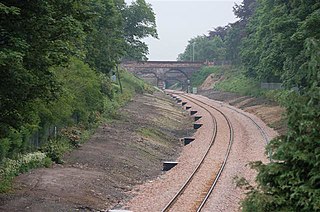
The Fife Circle Line is the local rail service north from Edinburgh. It links towns of south Fife and the coastal towns along the Firth of Forth before heading to Edinburgh. Operationally, the service is not strictly a circle route, but, rather, a point to point service that reverses at the Edinburgh end, and has a large bi-directional balloon loop at the Fife end.

Stirling railway station is a railway station located in Stirling, Scotland. It is located on the former Caledonian Railway main line between Glasgow and Perth. It is the junction for the branch line to Alloa and is also served by trains on the Edinburgh to Dunblane Line and long-distance services to Dundee and Aberdeen and to Inverness via the Highland Main Line.
Stirling Burghs was a district of burghs constituency of the House of Commons of the Parliament of the United Kingdom from 1708 to 1918.

Dunfermline Queen Margaret railway station is a railway station in Dunfermline, Fife, Scotland. The station is managed by ScotRail and is on the Fife Circle Line, 18+1⁄2 miles (29.8 km) north of Edinburgh Waverley. The station takes its name from the nearby Queen Margaret Hospital. It is the longest railway station name in Scotland.

The Stirling–Alloa–Kincardine rail link is a completed railway project to re-open 21 kilometres (13 mi) of railway between Stirling, Alloa and Kincardine in Scotland. The route opened to rail traffic in March 2008.

Alloa railway station is a railway station in the town of Alloa, Clackmannanshire, Scotland.

The Stirling and Dunfermline Railway was a railway in Scotland connecting Stirling and Dunfermline. It was planned by the Edinburgh and Glasgow Railway to get access to the mineral deposits on the line of route, but also as a tactical measure to keep the rival Caledonian Railway out of Fife.
The Kincardine Line is a railway in Clackmannanshire and Fife, Scotland. The line, which was opened in two stages by the North British Railway, was built to serve settlements between Alloa and Dunfermline along the north shore of the Firth of Forth. It was a never profitable railway; passenger services were withdrawn in 1930, goods in 1962.
The Edinburgh and Northern Railway was a railway company authorised in 1845 to connect Edinburgh to both Perth and Dundee. It relied on ferry crossings of the Firth of Forth and the Firth of Tay, but despite those disadvantages it proved extremely successful. It took over a short railway on the southern shore of the Forth giving a direct connection to Edinburgh, and it changed its name to the Edinburgh, Perth and Dundee Railway.

Alva railway station was a station in the village of Alva, in the Scottish county of Clackmannanshire. The station was the terminus of a branch from Cambus on the Stirling to Dunfermline Lower line.

Abbot House is the oldest secular building in Dunfermline, Scotland. Lying in the shadow of Dunfermline's great abbey church, the core of the building is 16th-century. A heritage centre until August 2015, the centre closed following failed attempts by Abbot House Heritage Centre Trust to find alternative funding.
The Railways of Kinross were a local network of three rural railways which made the town of Kinross in Scotland their objective in the 1850s.
The Dunfermline and Queensferry Railway was a railway company founded to form part of a rail and ferry route between Dunfermline and Edinburgh, in Scotland. It was authorised in 1873 and its promoters had obtained informal promises from the larger North British Railway that the NBR would provide financial help, and also operate the ferry and the necessary railway on the southern side of the Firth of Forth.
South Alloa railway station, located south of the River Forth, served the village of South Alloa, Scotland and the town of Alloa via a ferry link from 1850 to 1885.
Leuchars (Old) railway station served the town of Leuchars, Fife, Scotland from 1848 to 1921 on the Edinburgh and Northern Railway.
Blackgrange railway station was a temporary station that served the village of Cambus, Clackmannanshire, Scotland, in 1852 on the Stirling and Dunfermline Railway.

Cambus railway station served the suburb of Cambus, Clackmannanshire, Scotland from 1852 to 1968 on the Stirling and Dunfermline Railway.
Clackmannan Road railway station served the town of Clackmannan, Clackmannanshire, Scotland from 1850 to 1921 on the Stirling and Dunfermline Railway.

Forest Mill railway station served the hamlet of Forestmill, Clackmannanshire, Scotland from 1850 to 1930 on the Stirling and Dunfermline Railway.
East Grange railway station served the area of East Grange, Fife, Scotland, from 1850 to 1958 on the Stirling and Dunfermline Railway.










